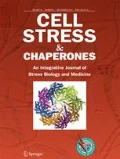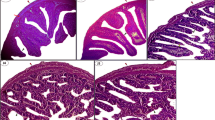Abstract
Liver damage is the most severe complication of heat stress (HS). Hydrolyzed camel whey protein (CWP) possesses bioactive peptides with obviously antioxidant and anti-inflammatory activities. The current study aims to investigate whether CWP that is hydrolyzed by a simulated gastrointestinal digestion process, named S-CWP, protects BRL-3A hepatocytes from HS-induced damage via antioxidant and anti-inflammatory mechanisms. BRL-3A cells were pretreated with S-CWP before being treated at 43 °C for 1 h, and the levels of the cellular oxidative stress, inflammation, apoptosis, biomarkers for liver function, the activities of several antioxidant enzymes, and the cell viability were analyzed. The expression level of pivotal proteins in correlative signaling pathways was evaluated by western blotting. We confirmed that S-CWP alleviated HS-induced hepatocytes oxidative stress by decreased reactive oxygen species (ROS), nitric oxide (NO), 8-Hydroxy-2′-deoxyguanosine (8-OHdG), lipid peroxidation (LPO), protein carbonylation (PCO), and the activities of NADPH oxidase while enhanced superoxide dismutase (SOD), catalase (CAT), glutathione peroxidase (GSH-Px), heme oxygenase-1 (HO-1) activities, and GSH content. S-CWP suppressed HS-induced inflammatory response by reducing the phosphorylation of NF-κB p65, the expression of NLRP3, and caspase-1 and finally alleviated caspase-3-mediated apoptosis. S-CWP also alleviated HS-induced hepatocyte injury by reducing alanine aminotransferase (ALT), aspartate aminotransferase (AST), and alkaline phosphatase (ALP) levels and restoring Heat Shock Protein 70 (HSP70) expression. Furthermore, S-CWP treatment significantly enhanced the expression of NF-E2-related nuclear factor erythroid-2 (Nrf2) and HO-1. The antioxidant and anti-inflammatory effects of S-CWP were weakened by ML385, a specific Nrf2 inhibitor. Additionally, zinc protoporphyrin (ZnPP), a specific HO-1 inhibitor, significantly reversed S-CWP-induced reduction in the phosphorylation of NF-κB p65. Thus, our results revealed that S-CWP protected against HS-induced hepatocytes damage via activating the Nrf2/HO-1 signaling pathway and inhibiting NF-κB/NLRP3 axis.







Similar content being viewed by others
References
Abdel-Aziem SH, Hassan AM, Abdel-Wahhab MA (2011) Dietary supplementation with whey protein and ginseng extract counteracts oxidative stress and DNA damage in rats fed an aflatoxin-contaminated diet. Mutat Res 723:65–71. https://doi.org/10.1016/j.mrgentox.2011.04.007
Abraham NG, Lutton JD, Levere RD (1985) Heme metabolism and erythropoiesis in abnormal iron states: role of delta-aminolevulinic acid synthase and heme oxygenase. Exp Hematol 13:838–843
Akbarian A, Michiels J, Degroote J, Majdeddin M, Golian A, De Smet S (2016) Association between heat stress and oxidative stress in poultry; mitochondrial dysfunction and dietary interventions with phytochemicals. J Anim Sci Biotechnol 7:37. https://doi.org/10.1186/s40104-016-0097-5
Altan O, Pabuccuoglu A, Altan A, Konyalioglu S, Bayraktar H (2003) Effect of heat stress on oxidative stress, lipid peroxidation and some stress parameters in broilers. Br Poult Sci 44:545–550. https://doi.org/10.1080/00071660310001618334
Andersen HR, Nielsen JB, Nielsen F, Grandjean P (1997) Antioxidative enzyme activities in human erythrocytes. Clin Chem 43:562–568
Asea A, Kraeft SK, Kurt-Jones EA, Stevenson MA, Chen LB, Finberg RW, Koo GC, Calderwood SK (2000) HSP70 stimulates cytokine production through a CD14-dependant pathway, demonstrating its dual role as a chaperone and cytokine. Nat Med 6:435–442
Asea A et al (2002) Novel signal transduction pathway utilized by extracellular HSP70: role of toll-like receptor (TLR) 2 and TLR4. J Biol Chem 277:15028–15034. https://doi.org/10.1074/jbc.M200497200
Badr G, Ramadan NK, Sayed LH, Badr BM, Selamoglu Z (2017a) Why whey? Camel whey protein as a new dietary approach to the management of free radicals and for the treatment of different health disorders. Iran J Basic Med Sci 20:338–349
Badr G, Sayed LH, Omar HEM, Abd El-Rahim AM, Ahmed EA, Mahmoud MH (2017b) Camel whey protein protects B and T cells from apoptosis by suppressing activating transcription Factor-3 (ATF-3)-mediated oxidative stress and enhancing phosphorylation of AKT and IkappaB-alpha in type I diabetic mice. Cell Physiol Biochem 41:41–54. https://doi.org/10.1159/000455935
Badr G, Abdel-Tawab HS, Ramadan NK, Ahmed SF, Mahmoud MH (2018a) Protective effects of camel whey protein against scrotal heat-mediated damage and infertility in the mouse testis through YAP/Nrf2 and PPAR-gamma signaling pathways. Mol Reprod Dev 85:505–518. https://doi.org/10.1002/mrd.22987
Badr G, Ramadan NK, Abdel-Tawab HS, Ahmed SF, Mahmoud MH (2018b) Camel whey protein protects lymphocytes from apoptosis via the PI3K-AKT, NF-kappaB, ATF-3, and HSP-70 signaling pathways in heat-stressed male mice. Biochem Cell Biol 96:407–416. https://doi.org/10.1139/bcb-2017-0217
Chen HY, Mollstedt O, Tsai MH, Kreider RB (2014) Potential clinical applications of multi-functional milk proteins and peptides in cancer management. Curr Med Chem 21:2424–2437. https://doi.org/10.2174/0929867321666140205135739
Corrochano AR, Buckin V, Kelly PM, Giblin L (2018) Invited review: whey proteins as antioxidants and promoters of cellular antioxidant pathways. J Dairy Sci 101:4747–4761. https://doi.org/10.3168/jds.2017-13618
Corrochano AR et al (2019) Bovine whey peptides transit the intestinal barrier to reduce oxidative stress in muscle cells. Food Chem 288:306–314. https://doi.org/10.1016/j.foodchem.2019.03.009
Elagamy EI (2000) Effect of heat treatment on camel milk proteins with respect to antimicrobial factors: a comparison with cows’ and buffalo milk proteins 68:227–232
Geng Y et al (2015) Heatstroke induces liver injury via IL-1beta and HMGB1-induced pyroptosis. J Hepatol 63:622–633. https://doi.org/10.1016/j.jhep.2015.04.010
Gillies LA, Kuwana T (2014) Apoptosis regulation at the mitochondrial outer membrane. J Cell Biochem 115:632–640
Glory A, Averill-Bates DA (2016) The antioxidant transcription factor Nrf2 contributes to the protective effect of mild thermotolerance (40°C) against heat shock-induced apoptosis. Free Radic Biol Med 99:485–497. https://doi.org/10.1016/j.freeradbiomed.2016.08.032
Guo H, Callaway JB, Ting JP (2015) Inflammasomes: mechanism of action, role in disease, and therapeutics. Nat Med 21:677–687. https://doi.org/10.1038/nm.3893
Hamed H, Gargouri M, Boulila S, Chaari F, Ghrab F, Kallel R, Ghannoudi Z, Boudawara T, Chaabouni S, Feki AE, Gargouri A (2018) Fermented camel milk prevents carbon tetrachloride induced acute injury in kidney of mice. J Dairy Res 85:251–256. https://doi.org/10.1017/S0022029918000250
Hassanein T, Razack A, Gavaler JS, Van Thiel DH (1992) Heatstroke: its clinical and pathological presentation, with particular attention to the liver. Am J Gastroenterol 87:1382–1389
Hybertson BM, Gao B, Bose SK, McCord JM (2011) Oxidative stress in health and disease: the therapeutic potential of Nrf2 activation. Mol Asp Med 32:234–246. https://doi.org/10.1016/j.mam.2011.10.006
Ibrahim HR, Isono H, Miyata T (2018) Potential antioxidant bioactive peptides from camel milk proteins. Anim Nutr (Zhongguo xu mu shou yi xue hui) 4:273–280. https://doi.org/10.1016/j.aninu.2018.05.004
Korish AA, Arafah MM (2013) Camel milk ameliorates steatohepatitis, insulin resistance and lipid peroxidation in experimental non-alcoholic fatty liver disease. BMC Complement Altern Med 13:264
Li C et al (2019) Screening of the hepatotoxic components in Fructus Gardeniae and their effects on rat liver BRL-3A cells. Molecules 24. https://doi.org/10.3390/molecules24213920
Lord-Fontaine S, Averill-Bates DA (2002) Heat shock inactivates cellular antioxidant defenses against hydrogen peroxide: protection by glucose. Free Radic Biol Med 32:752–765. https://doi.org/10.1016/s0891-5849(02)00769-4
Martine P, Chevriaux A, Derangere V, Apetoh L, Garrido C, Ghiringhelli F, Rebe C (2019) HSP70 is a negative regulator of NLRP3 inflammasome activation. Cell Death Dis 10:256. https://doi.org/10.1038/s41419-019-1491-7
Matsuda-Minehata F, Maeda A, Cheng Y, Sai T, Manabe N (2007) Regulation of granulosa cell apoptosis by death ligand–receptor signaling. Anim Sci J 79:1–10
Mihic T, Rainkie D, Wilby KJ, Pawluk SA (2016) The therapeutic effects of camel milk: a systematic review of animal and human trials. J Evid Based Complement Altern Med 21:NP110–NP126. https://doi.org/10.1177/2156587216658846
Miller-Cushon EK, Dayton AM, Horvath KC, Monteiro APA, Weng X, Tao S (2019) Effects of acute and chronic heat stress on feed sorting behaviour of lactating dairy cows. Animal:1–8. https://doi.org/10.1017/S1751731118003762
Nawab A, Ibtisham F, Li G, Kieser B, Wu J, Liu W, Zhao Y, Nawab Y, Li K, Xiao M, An L (2018) Heat stress in poultry production: mitigation strategies to overcome the future challenges facing the global poultry industry. J Therm Biol 78:131–139. https://doi.org/10.1016/j.jtherbio.2018.08.010
Nielsen PM, Petersen D, Dambmann C (2001) Improved method for determining food protein degree of hydrolysis. J Food Sci 66:642–646
O'Keeffe MB, FitzGerald RJ (2014) Antioxidant effects of enzymatic hydrolysates of whey protein concentrate on cultured human endothelial cells. Int Dairy J 36:128–135. https://doi.org/10.1016/j.idairyj.2014.01.013
Power-Grant O, Bruen C, Brennan L, Giblin L, Jakeman P, FitzGerald RJ (2015) In vitro bioactive properties of intact and enzymatically hydrolysed whey protein: targeting the enteroinsular axis. Food Funct 6:972–980. https://doi.org/10.1039/c4fo00983e
Ramadan NK, Badr G, Abdel-Tawab HS, Ahmed SF, Mahmoud MH (2018) Camel whey protein enhances lymphocyte survival by modulating the expression of survivin, bim/bax, and cytochrome C and restores heat stress-mediated pathological alteration in lymphoid organs. Iran J Basic Med Sci 21:896–904. https://doi.org/10.22038/IJBMS.2018.27584.6729
Reed TT (2011) Lipid peroxidation and neurodegenerative disease. Free Radic Biol Med 51:1302–1319. https://doi.org/10.1016/j.freeradbiomed.2011.06.027
Saito K, Dai Y, Ohtsuka K (2005) Enhanced expression of heat shock proteins in gradually dying cells and their release from necrotically dead cells. Exp Cell Res 310:229–236
Salami M, Moosavi-Movahedi AA, Ehsani MR, Yousefi R, Haertlé T, Chobert JM, Razavi SH, Henrich R, Balalaie S, Ebadi SA, Pourtakdoost S, Niasari-Naslaji A (2010) Improvement of the antimicrobial and antioxidant activities of camel and bovine whey proteins by limited proteolysis. J Agric Food Chem 58:3297–3302. https://doi.org/10.1021/jf9033283
Shen H et al (2014) Mouse hepatocyte overexpression of NF-kappaB-inducing kinase (NIK) triggers fatal macrophage-dependent liver injury and fibrosis. Hepatology (Baltimore, Md) 60:2065–2076. https://doi.org/10.1002/hep.27348
Sies H, Berndt C, Jones DP (2017) Oxidative Stress. Annu Rev Biochem 86:715–748. https://doi.org/10.1146/annurev-biochem-061516-045037
Slimen IB, Najar T, Ghram A, Dabbebi H, Ben Mrad M, Abdrabbah M (2014) Reactive oxygen species, heat stress and oxidative-induced mitochondrial damage. A review. Int J Hyperth 30:513–523. https://doi.org/10.3109/02656736.2014.971446
Song J-H, Kim K-J, Chei S, Seo Y-J, Lee K, Lee B-Y (2018) Korean red ginseng and Korean black ginseng extracts, JP5 and BG1, prevent hepatic oxidative stress and inflammation induced by environmental heat stress. J Ginseng Res. https://doi.org/10.1016/j.jgr.2018.12.005
Sudo H, Minami A (2010) Regulation of apoptosis in nucleus pulposus cells by optimized exogenous Bcl-2 overexpression. J Orthop Res Off Publ Orthop Res Soc 28:1608–1613
Szabo G, Csak T (2012) Inflammasomes in liver diseases. J Hepatol 57:642–654. https://doi.org/10.1016/j.jhep.2012.03.035
Udenigwe CC, Aluko RE (2012) Food protein-derived bioactive peptides: production, processing, and potential health benefits. J Food Sci 77:R11–R24. https://doi.org/10.1111/j.1750-3841.2011.02455.x
Wang R, Han Z, Ji R, Xiao Y, Si R, Guo F, He J, Hai L, Ming L, Yi L (2020) Antibacterial activity of trypsin-hydrolyzed camel and cow whey and their fractions. Animals (Basel) 10:10. https://doi.org/10.3390/ani10020337
Wardyn JD, Ponsford AH, Sanderson CM (2015) Dissecting molecular cross-talk between Nrf2 and NF-κB response pathways. Biochem Soc Trans 43:621–626. https://doi.org/10.1042/bst20150014
Weigand K, Riediger C, Stremmel W, Flechtencher C, Encke J (2007) Are heat stroke and physical exhaustion underestimated causes of acute hepatic failure? World J Gastroenterol 13:306–309. https://doi.org/10.3748/wjg.v13.i2.306
Xu D, Xu M, Jeong S, Qian Y, Wu H, Xia Q, Kong X (2018) The role of Nrf2 in liver disease: novel molecular mechanisms and therapeutic approaches. Front Pharmacol 9:1428. https://doi.org/10.3389/fphar.2018.01428
Yan W et al (2012) High-mobility group box 1 activates caspase-1 and promotes hepatocellular carcinoma invasiveness and metastases. Hepatology (Baltimore, Md) 55:1863–1875. https://doi.org/10.1002/hep.25572
Zaboli G, Huang X, Feng X, Ahn DU (2019) How can heat stress affect chicken meat quality? - a review. Poult Sci 98:1551–1556. https://doi.org/10.3382/ps/pey399
Acknowledgments
The authors gratefully acknowledge the fund supports. I would like to show my deepest gratitude to Dr. Chunyu Liu for his great help in cell culture.
Funding
This research was funded by the National Natural Science Foundation of China (32060815) and Natural Science Foundation of Inner Mongolia (2020MS03011).
Author information
Authors and Affiliations
Contributions
Donghua Du, Wenting Lv, and Surong Hasi conceived and designed the study; Donghua Du, Rina Su, and Chunwei Yu carried out the investigation; Xiaoxia Jing and Nuwenqimuge Bai contributed analysis data; Donghua Du and Chunwei Yu analyzed the data and drafted the manuscript; and Surong Hasi edited the manuscript. All authors read and approved the final manuscript.
Corresponding author
Ethics declarations
Conflict of interest
The authors declare that they have no conflict of interest.
Additional information
Publisher’s note
Springer Nature remains neutral with regard to jurisdictional claims in published maps and institutional affiliations.
Rights and permissions
About this article
Cite this article
Du, D., Lv, W., Su, R. et al. Hydrolyzed camel whey protein alleviated heat stress-induced hepatocyte damage by activated Nrf2/HO-1 signaling pathway and inhibited NF-κB/NLRP3 axis. Cell Stress and Chaperones 26, 387–401 (2021). https://doi.org/10.1007/s12192-020-01184-z
Received:
Revised:
Accepted:
Published:
Issue Date:
DOI: https://doi.org/10.1007/s12192-020-01184-z




